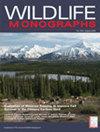Life-history characteristics of mule deer: Effects of nutrition in a variable environment Características de historia de vida del ciervo mulo: el Efecto de la nutrición en presencia de un medio ambiente variable Traits Biodémographiques chez le Cerf Mulet: Effets de la Nutrition dans un Environnement Variable
Abstract
Vital rates of large herbivores normally respond to increased resource limitation by following a progressive sequence of effects on life-history characteristics from survival of young, age at first reproduction, reproduction of adults, to adult survival. Expected changes in life-history characteristics, however, should operate through changes in nutritional condition, which is the integrator of nutritional intake and demands represented primarily by the deposition and catabolism of body fat. Elucidating seasonal patterns of nutritional condition and its relative influence on individual and population performance should improve our understanding of life-history strategies and population regulation of ungulates, provide insight into the capacity of available habitat to support population growth, and allow assessment of the underlying consequences of mortality on population dynamics. We acquired longitudinal data on individual female mule deer (Odocoileus hemionus), and linked those data with environmental and population characteristics. Our goal was to provide a nutritional basis for understanding life-history strategies of these large mammals, and to aid in the conservation and management of large herbivores in general. We studied a migratory population of mule deer that overwintered in Round Valley on the east side of the Sierra Nevada, California, USA, and was subject to a highly variable climate and predation from a suite of large carnivores. We intensively monitored nutritional and life-history characteristics of this population during 1997–2009 as it recovered from a population crash, which occurred during 1985–1991. Deer in Round Valley migrated to high-elevation summer ranges on both sides of the crest of the Sierra Nevada (Sierra crest), where a rain shadow resulted in a mesic and more forested range on the west side compared with xeric conditions east of the Sierra crest. Average survival of neonatal mule deer to 140 days of age during 2006–2008 was 0.33 (SE = 0.091), but was lower for neonates on the west side (0.13, SE = 0.092) compared with those on the east side (0.44, SE = 0.11) of the Sierra crest. Birth mass and nutritional condition of mothers had a positive effect on survival of young; however, those effects were evident only for neonates born east of the crest where predation pressure was less intense compared with the west side. Black bear (Ursus americanus) predation was the main cause of mortality for west-side young (mortality rate = 0.63, SE = 0.97) compared with canid and felid predation for east-side young (0.29, SE = 0.076). Mean autumn recruitment of young during 1997–2008 was lower for females on the west side (0.42, SE = 0.037) than for females on the east side (0.70, SE = 0.041) of the crest, and was affected positively by March ingesta-free body fat (IFBFat) of individual females. At the level of the population, ratios of young-to-adult females (1991–2009) were highly variable and strongly related to March IFBFat of adult females during the current and preceding year. Reproduction by yearling females was sensitive to per capita availability of forage during summer (as 1-yr-old individuals), thereby influencing whether a sufficient body mass for ovulation was obtained. Litter size remained high (1.69, SE = 0.027) during the study, but was influenced positively by forage availability, negatively by summer temperature, and was greater for females that resided on the west side of the Sierra crest during summer than those on the east side. In contrast, pregnancy rates remained unchanged across years of study (0.98, SE = 0.005). Survival of prime-age (2- to 9-yr-old) females was 0.90 (SE = 0.021) in summer, 0.94 (SE = 0.012) in winter, and 0.87 (SE = 0.025) annually. Although relatively stable across years, both winter and summer survival were influenced positively by the preceding April snowpack relative to the density of the population. Mean IFBFat of adult females was 7.2% (SE = 0.077) in March 1997–2009 and 9.7% (SE = 0.23) in November 2002–2008. Nutritional condition offered a mechanistic link between factors that influence resource limitation and population performance, because condition of adult females in autumn and late winter was sensitive to the nutritional history of individual animals as related to forage growth, population density, migratory tactic, reproductive costs, and nutritional carryover. Nutritional condition of adult females in March also was the most parsimonious predictor of finite rate of population growth (λ) during the forthcoming year. The relative magnitude of effect of nutritional condition on survival and reproduction was mostly in accordance with the predicted changes of vital rates in response to resource limitation for populations of large herbivores. Our results indicate that management and conservation of large herbivore populations could be improved by integrating indices of nutritional condition into current monitoring and research programs. We offer a method to estimate the proximity of a population to nutritional carrying capacity (NCC) that is based on nutritional status of the population relative to population performance (termed animal-indicated NCC). The proximity of the population to animal-indicated NCC represents the short-term capacity of the environment to support population growth. A nutritional approach to monitor and manage populations offers a direct link to the capacity of the habitat, and reduces the need to estimate population abundance or set goals according to population size. We also propose that the consequences of mortality (degree of additive or compensatory mortality) on population dynamics can be assessed by comparing the estimated nutritional capacity for survival and recruitment of young to that measured empirically, because more young are produced than what the habitat can support when nutrition is limiting. Our approach is useful for quantifying effects of predation, and provides a basis for determining the efficacy of predator control to enhance ungulate populations. © 2014 The Wildlife Society.

 求助内容:
求助内容: 应助结果提醒方式:
应助结果提醒方式:


